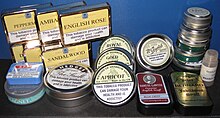
Back Snuif Afrikaans Schnupftabak ALS العاطوس (التبغ) Arabic النشوق (تبغ) ARZ Schmei BAR Табака Byelorussian Табака BE-X-OLD Енфие Bulgarian Rapè Catalan Šňupací tabák Czech



Snuff is a type of smokeless tobacco product made from finely ground or pulverized tobacco leaves.[1] It is snorted or "sniffed" (alternatively sometimes written as "snuffed") into the nasal cavity, delivering nicotine and a flavored scent to the user (especially if flavoring has been blended with the tobacco).[1] Traditionally, it is sniffed or inhaled lightly after a pinch of snuff is either placed onto the back surface of the hand, held pinched between thumb and index finger, or held by a specially made "snuffing" device.
Snuff originated in the Americas and was commonly used in Europe by the 17th century. Traditional snuff production consists of a lengthy, multi-step process, in tobacco snuff mills.[1] The selected tobacco leaves are first subject to special tobacco curing or fermentation processes, where they will later provide the individual characteristics and flavor for each type of snuff blend.[1] Snuff is usually scented or flavored, with many blends of snuff requiring months to years of special storage to reach the required maturity.[1] Typical traditional flavors are varieties of blended tobacco leaves considered original "fine snuff" without any addition of scents or essences.[1] Varieties of spice, piquant, fruit, floral, and mentholated (also called "medicated") soon followed, either pure or in blends.[1] Each snuff manufacturer usually has a variety of unique recipes and blends, as well as special recipes for individual customers.[1] Common flavors also include coffee, chocolate, bordeaux, honey, vanilla, cherry, orange, apricot, plum, camphor, cinnamon, rose and spearmint. Modern flavors include bourbon, cola and whisky. Traditional classic German snuff blends are the pungent and sharp Schmalzler and Brasil blends.
Snuff comes in a range of texture and moistness, from very fine to coarse, and from toast (very dry) to very moist.[1] Often drier snuffs are ground more finely. There is also a range of tobacco-free snuffs, such as Pöschl's Weiss (White), made from glucose powder or herbs. While strictly speaking, these are not snuffs because they contain no tobacco, they are an alternative for those who wish to avoid nicotine, or for "cutting" a strong snuff to an acceptable strength.